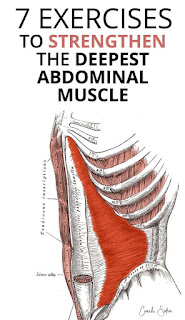7 Best Transverse Abdominis Activation Exercises
In just a few moments, I’m going to share with you 7 powerful deep core exercises that’ll target the transverse abdominis (TVA) – one of your deepest abdominal muscles.
I’ll also explain a bit how to properly engage this muscle and signs and symptoms of a weak deep core and inactive transverse abdominis. If you experience lower back pain, there is a good chance this muscle is weak or is failing to engage on time…
So make sure you practice daily. The more you do the exercises mindfully, the better your mind-muscle connection will get. So don’t quit after just a day or two. Keep practicing.
Activating and strengthening these deep core muscles (and the transverse abdominis in particular) will help you get immediate relief from lower back pain, as well as support and protect your spine from flare-ups. Make sure you perform these exercises on a weekly basis.
Before I demonstrate how to do these exercises, I want to take a minute to briefly explain the inner and outer core units, their function and why you need to avoid any type of core exercise that puts your spinal in a flexed position (such as crunches).
The Core Units
The core consists of an inner, and an outer unit. These units are always working together to enable us to accomplish simple daily tasks to more advanced athletic performance.

Engaging The Transverse Abdominis (Deep Core)
The inner core unit is what’s known as the deep core. The deep core muscles act as the spine’s safety belt. These muscles also work with the glutes and hip flexors to stabilize the pelvis. In simple terms, the deep core consists of the following muscles:
- Transverse abdominis: a deep abdominal muscle that works like a belt around your waist to protect your spine. Picking an item off the floor without properly activating this muscle will overload the lower back and pelvis which can lead to injury.
- Multifidus: Another important muscle stabilizer connected to the pelvis.
- Pelvic floor.
Typical abdominal exercises such as crunches won’t activate these deep core muscles. In addition, if these muscles are weak and inactive, they’ll contribute to more compensation during regular exercise.
The Outer Core Unit
The outer core consists of the prime mover muscles and these are the visible abs (rectus abdominis), the external obliques, the shoulder girdle.
When you’re engaging in exercises such as crunches, you’re only working the visible abs to achieve that “aesthetic look”. But our goal is to build a healthy balanced body… One that is composed of “intelligent” aesthetic muscles and a strong foundation (1).
There is nothing wrong with working your abs. Just make sure you’re also working on that inner foundation. I promise you’ll feel the difference also in your abs. When the inner core is strong, the outer core functions better also.
Signs and Symptoms of A Weak Transverse Abominis
One of the warning signs of a weak inner core is feeling the tension in your lower back and hip flexors when you perform certain abs exercises like the bicycle or the lying leg lifts. In addition, if you perform the bridge exercise to strengthen your glutes and feel pressure in your lower back and/or hamstrings, that’s another sign of a weak transverse abdominis.
I created a video to demonstrate the deep core exercises. If you can’t watch it right now, just scroll down below the video to view the exercise images. I’ve also included additional tips on how to strengthen your core if you have lower back or hip pain, and some important points to keep in mind as you integrate these exercises into your life.
7 Exercises To Activate The Transverse Abdominis (Full Workout)
Core Exercises Breakdown:
Single-leg extensions

Dynamic toe-taps

Plank knee to elbow

Double leg lower and lift

It’s very important to have your back touching the floor all the time. Take as much rest as you want, but make sure you are performing each repetition properly).
Bird dog

Make sure you are not rotating your hips.
Plank shoulder taps

Focus on maintaining a solid plank position without dropping your hips or lifting your glutes up).
Plank knee taps

Important Tips To Keep In Mind…
- Keep your back glued to your mat when you are on your back. If you arch your back, that means you’re starting to compensate and shifting the tension to your lower back instead of your core. You should take a break, breathe and try to do it again with proper form.
- You can start with 10-15 repetitions for each core exercise, and as you gain more strength, bump those reps up to 15, or do 2 sets of 10-15 reps.
- Take from 30-60 seconds break between each exercise. Our goal is to strengthen our inner goal, not to build abs. (for now!)
What If You Have Back Pain
If you are experiencing lower back pain, avoid ab exercises such as sit-ups, crunches or anything involving twisting (like the Russian twists). Crunches contribute to a flexed posture (rounded shoulder-forward head posture) and twisting create micro-tears in the discs making your spine more vulnerable to injury.
Free Report: The Most Important Steps To Get Long-Term Relief From Back Pain
Exercises To Avoid If You Have Disc Herniation
If you’re suffering from a disc-related injury, you want to avoid core or abs exercises that include exaggerated flexion or extension. Here’s an example… if you have an anterior disc herniation (facing the front side of the intervertebral disc. Towards the body), you’ll notice pain when you do hyperextension exercises.
Likewise, if you have a posterior disc herniation (towards the back of the body), you’d experience pain when bending over, and doing the typical abs flexion exercises
To keep things balanced, I like to simply avoid all exercises that promote flexion or exaggerated extension. This also applies to stretches. While extension can be beneficial to help restore your posture (especially if you spend the majority of your time sitting hunched over), try to avoid going to the extremes. For example, if you like to perform the cobra exercise…
Instead of doing a high cobra with my hands pressing against the floor, I prefer to go low resting on my forearms, or making a fist with my hand and just resting my head on my hand instead.
Glad you made it this far! I hope you found this post helpful. It’s extremely important to work on your inner core. A strong core will protect your spine from pain and injury. Schedule time every day to do at least a few exercises. And if you’d like a powerful program to help you build a solid core that’ll protect your spine and pelvis, check out the Back Pain Bootcamp.





Comments
Post a Comment